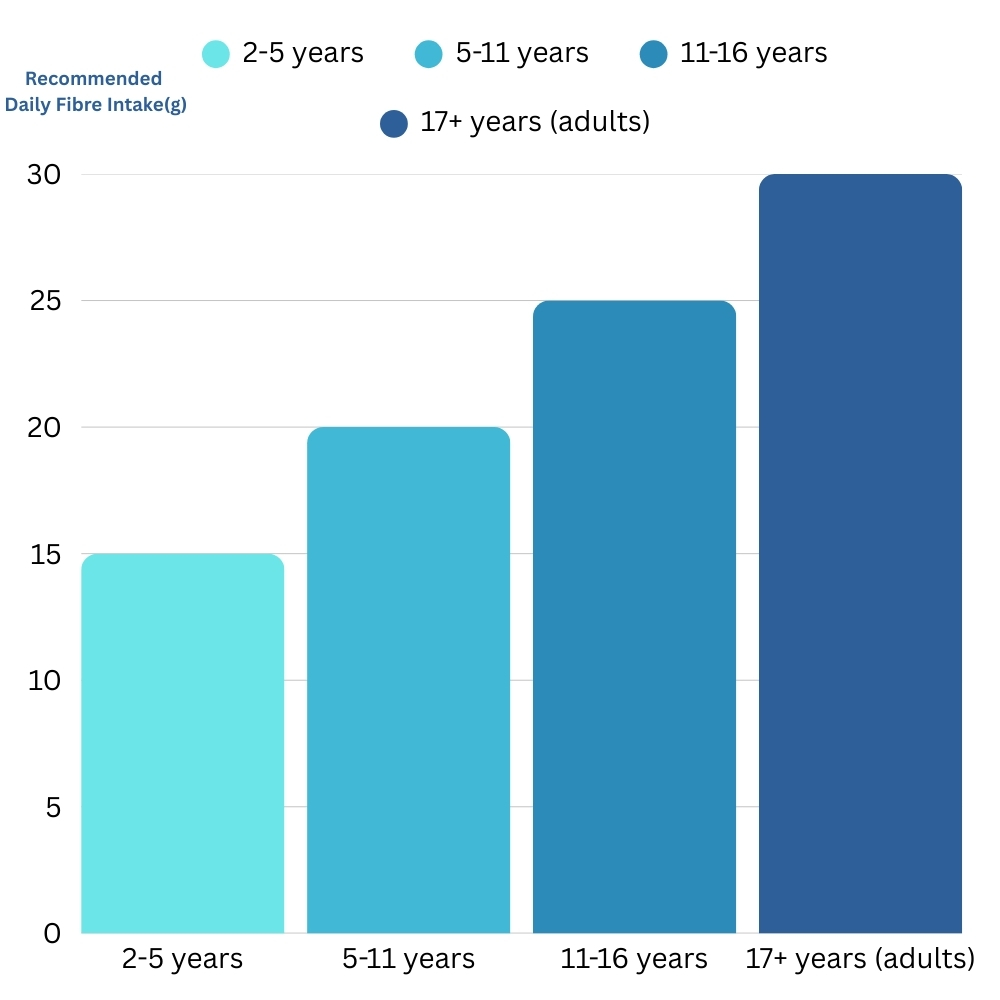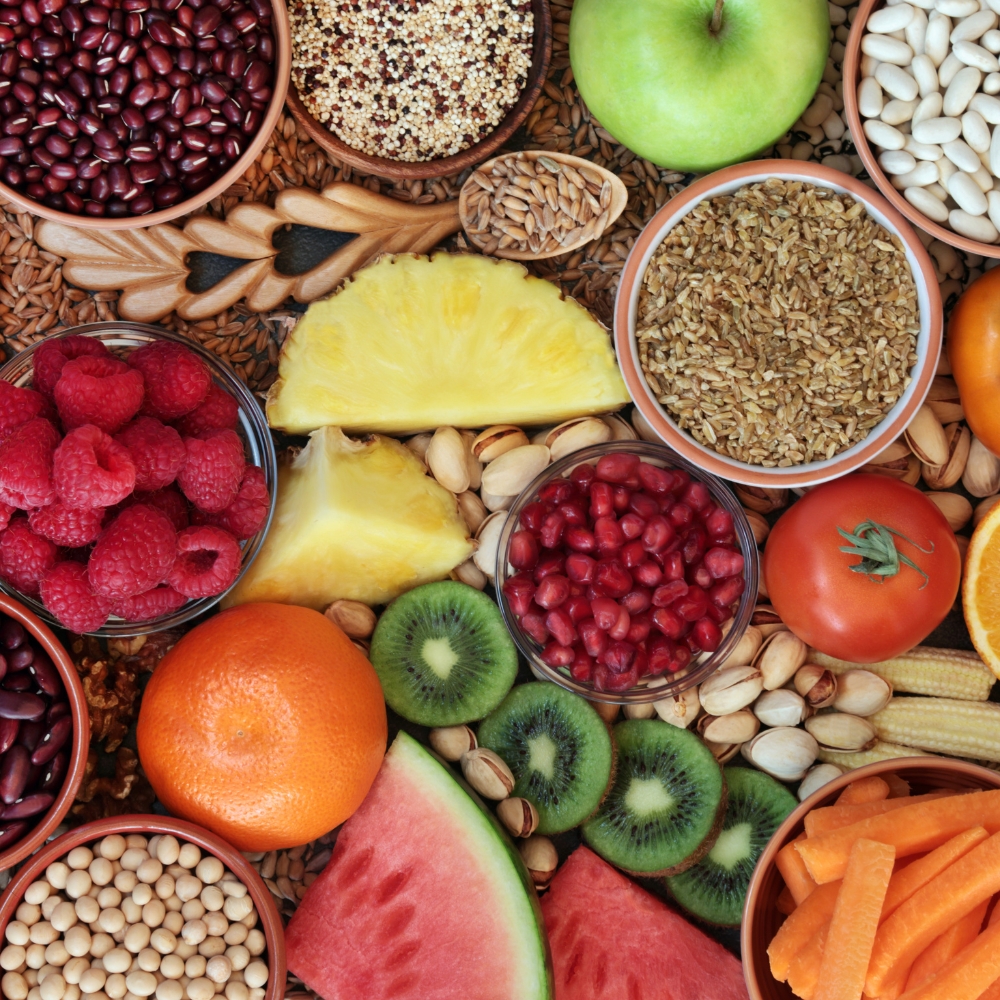Fibre has often been called the forgotten nutrient. Unlike protein, carbs, or fats, it doesn’t provide calories, and perhaps because of this it rarely takes the spotlight. Yet fibre is quietly essential to our health and wellbeing. It keeps our digestion moving, nurtures our gut bacteria, balances hormones, protects against chronic disease, and even supports our mental health. Fibre is a gift from plants to us – a structural part of foods that becomes a structural part of our health.
Why Do We Need Fibre?
When we eat fibre, it resists digestion in the small intestine and travels down to the large intestine. There, it either bulks up the stool, absorbs water, or becomes a feast for our gut bacteria. These bacteria ferment certain types of fibre, producing short-chain fatty acids that help lower inflammation, protect the gut lining, and even influence blood sugar and cholesterol control.
Without enough fibre, digestion slows, blood sugar can spike and crash, cholesterol may creep up, and the risk of constipation, diverticular disease, and bowel cancer increases. A diet low in fibre also starves our gut microbiota, the living ecosystem inside us that thrives on plant diversity.
But despite all these benefits, most of us are eating far less fibre than we need.
Why Are We Not Eating Enough?
Modern diets are dominated by refined grains, fast food, and processed snacks. These foods are stripped of their natural fibre, leaving us with convenience but not nourishment. On top of that, fibre isn’t glamorous. It doesn’t come in shiny packaging or promise quick fixes, so it is easy to overlook. Many people also still believe fibre equals bland bran flakes or endless lettuce, which couldn’t be further from the truth.
In the UK, adults are advised to aim for 30 grams of fibre a day. Yet on average, people consume only around 18 grams. That gap matters because research consistently shows that diets rich in fibre protect against heart disease, type 2 diabetes, stroke, and bowel cancer.
The good news is that increasing fibre intake doesn’t need to be overwhelming. By understanding the different types of fibre and where to find them, you can build meals that are delicious, varied, and deeply supportive of your long-term health.
Types of Fibre

Fibre isn’t one single thing — it comes in different forms, each with unique benefits for your body. The two main categories are soluble fibre and insoluble fibre, and within them are even more specialised types.
Soluble Fibre
- What it does: Dissolves in water to form a gel-like substance.
- Benefits: Helps lower cholesterol, stabilises blood sugar, and keeps you feeling full.
- Food sources: Oats, chia seeds, beans, lentils, nuts, apples, blueberries.
Insoluble Fibre
- What it does: Does not dissolve in water. Instead, it adds bulk and speeds up the passage of food.
- Benefits: Promotes regular bowel movements and prevents constipation.
- Food sources: Whole wheat (especially bran), quinoa, brown rice, legumes, leafy greens, nuts, seeds, fruits with skins (like pears and apples).
Beyond Soluble & Insoluble
Fibre is often described by its functional properties:
- Viscous → forms gels, slowing digestion and blood sugar rise.
- Fermentable → feeds gut bacteria, producing short-chain fatty acids that support immunity, gut lining, and hormone balance.
- Non-fermentable → passes through unchanged, bulking up stool and easing constipation.
Where Fibre Comes From
The National Academy of Medicine defines fibre as two main types:
- Dietary fibre → naturally occurring in plant foods.
- Functional fibre → extracted or synthetically made, but still beneficial (e.g., added to foods or supplements).
Some fibres, like resistant starch and oligosaccharides, can belong to both categories — naturally present in foods but also made as supplements.
How much fibre do we need?
Fibre needs change across the lifespan.
Pregnant and breastfeeding women are advised to aim for the adult recommendation of 30 g daily.
These numbers can sound intimidating at first, but when you see them broken down into everyday meals, they become much more achievable.
Here is a helpful guide:

A day of eating to reach daily target
Here’s an example of how an adult can comfortably reach the recommended 30 g of fibre in one day:
- Breakfast: Porridge made with 40 g oats (4 g), topped with 1 tablespoon chia seeds (5 g), 1 medium apple (2 g), and a handful of raspberries (3 g). Total: 14 g
- Snack: Wholemeal toast (3 g) with peanut butter (1 g) and sliced banana (2 g). Total: 6 g
- Lunch: Lentil soup made with 150 g cooked lentils (8 g) plus vegetables like carrots and onions (2 g). Served with a slice of wholegrain bread (3 g). Total: 13 g
- Dinner: Grilled salmon with 150 g cooked quinoa (5 g), roasted broccoli (4 g), and a sweet potato (4 g). Total: 13 g
Grand Total: 46 g
This shows how easily fibre adds up when you base meals around wholegrains, legumes, fruit, and vegetables. Even if you don’t reach 46 g every day, consistently aiming for 30 g is absolutely within reach.
Training Ourselves to Eat More Fibre
Eating more fibre is not about punishment or rigid diets. It’s about training our taste buds and routines to embrace variety. Start with small swaps: white bread for wholemeal, refined cereal for oats, or crisps for a handful of nuts. Slowly increase your intake so your gut adapts, and always drink enough water to help fibre do its work.
Fibre is also about joy. Think colourful salads with beans, vibrant fruit bowls, hearty soups, and crunchy seeds sprinkled over porridge. When you see fibre not as a restriction but as an invitation to more colour, texture, and flavour, it becomes easy to enjoy.
Final Thoughts
Fibre is not a side note in nutrition – it’s a foundation. It protects, balances, nourishes, and strengthens us from the inside out. Most of us are eating far too little, but the solution is within reach: simple, everyday foods that bring pleasure as well as health. By making small, steady changes, we can meet our fibre needs, support our gut microbiome, and set ourselves up for better wellbeing across a lifetime.
Fibre is not about eating lettuce. It’s about embracing the full rainbow of plant foods, grains, beans, vegetables, fruit, nuts, and seeds – that make meals satisfying and life-giving. Every bite is a chance to care for your future self, one delicious step at a time.

